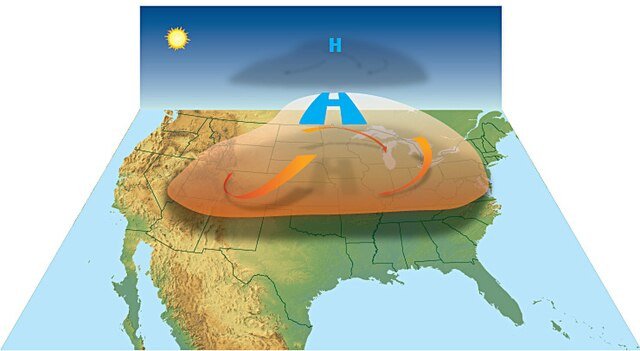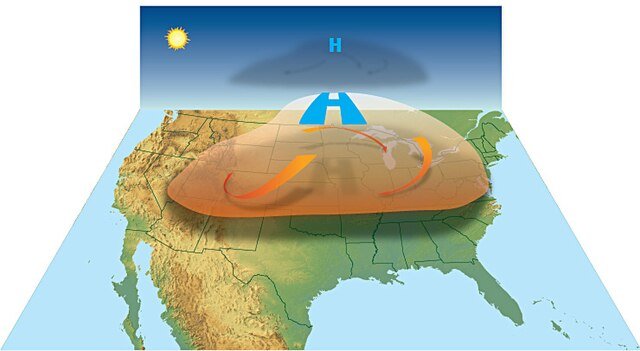
As the workweek begins, millions of Americans across the Midwest and Eastern United States brace for extreme and potentially dangerous temperatures. A massive heat dome, previously tormenting the Western states, has moved eastward, enveloping regions from Kansas and Texas to New York and South Carolina. Heat advisories and air quality alerts are widespread, with meteorologists warning of “major” and “extreme” heat that could pose serious health risks.
The National Weather Service (NWS) has forecast near-record temperatures for several cities. Tulsa, Oklahoma, is expected to hit 102°F on Monday afternoon, while New York City could reach 97°F on Tuesday. High humidity levels are exacerbating the situation, making it feel even hotter and more dangerous, especially for those without access to air conditioning.
“Extremely dangerous and potentially deadly heat, particularly for urban areas in the Southeast and East Coast, are forecast for Monday and Tuesday,” the NWS emphasized in a recent forecast discussion. The combination of high temperatures and humidity will push heat indices-the apparent temperature felt by the human body-to between 105°F and 110°F or higher in several areas, including Washington, D.C., Baltimore, and Philadelphia.
The current heat wave has already claimed numerous lives across the United States this summer. Prolonged exposure to such high temperatures can cause severe illness or even be fatal. The deadly heatwave that scorched Mexico, Central America, and the southern US in May and June was made 35 times more likely due to human-induced global warming, according to World Weather Attribution, a leading climate research group.
In addition to the heat, parts of the Midwest, including Illinois and Minneapolis, are facing threats of flash floods and tornadoes. The NWS has also issued red flag warnings in Oregon and Idaho, indicating critical fire weather conditions due to strong winds, low humidity, and warm temperatures.
The NWS predicts that the heat and humidity will peak on Tuesday afternoon. Relief is expected later in the week as cooler air from Canada moves southward. However, the Southeast is likely to continue experiencing oppressive heat.
Human-caused climate change is a significant factor in the increasing frequency and intensity of heatwaves. The Climate Shift Index from Climate Central indicates that human-induced climate change has made the current heat wave at least three times more likely in Washington, D.C. Moreover, hot overnight temperatures show an even stronger link to climate change.
“The extreme heat we’re seeing is a direct consequence of our continued reliance on fossil fuels and the greenhouse gases they emit,” said a climate scientist from Climate Central. “As the planet warms, we can expect to see more frequent and severe heatwaves, which will pose increasing risks to public health and safety.”
The impact of this heatwave is not limited to human health. California, which experienced a record-breaking heatwave earlier this month, continues to grapple with the aftermath. Wildfire risks have soared, with multiple large fires burning and red flag warnings in effect. An unusually wet winter followed by weeks of intense heat has left the state with abundant, extremely dry vegetation, fueling the wildfires.
“The US is already experiencing its second-warmest summer on record,” noted a spokesperson for the NWS. “With the continued intense heat through July and possibly into August, it’s likely that many cities will set new records for the warmest summer.”
As the nation faces these extreme temperatures, public health officials urge residents to take precautions. People are advised to stay indoors during the hottest parts of the day, drink plenty of water, and avoid strenuous activities. Special attention should be given to vulnerable populations, including the elderly, young children, and those with pre-existing health conditions.
Record-Breaking Heat Dome Engulfs Eastern and Midwestern US, Putting Millions at Risk
As the workweek begins, millions across the Midwest and Eastern United States brace for extreme and potentially dangerous temperatures due to a massive heat dome that has moved eastward. Covering areas from Kansas and Texas to New York and South Carolina, the heat dome has prompted widespread heat advisories and air quality alerts.
The National Weather Service (NWS) forecasts near-record temperatures, with cities like Tulsa, Oklahoma, expected to hit 102°F and New York City potentially reaching 97°F. High humidity levels exacerbate the heat, making conditions particularly perilous for those without air conditioning.
The NWS warns of "extremely dangerous and potentially deadly heat," especially in urban areas of the Southeast and East Coast. Heat indices could soar to between 105°F and 110°F or higher in cities like Washington, D.C., Baltimore, and Philadelphia.
This heat wave has already resulted in numerous fatalities this summer. Climate change, driven by human activities, has significantly increased the likelihood and intensity of such heatwaves. The Climate Shift Index from Climate Central indicates that human-induced climate change has made this current heat wave at least three times more likely in Washington, D.C.
Additionally, parts of the Midwest face threats of flash floods and tornadoes, while Oregon and Idaho are under red flag warnings due to critical fire weather conditions. Relief from the heat is expected later in the week as cooler air from Canada moves southward, although the Southeast will remain hot.
Public health officials urge residents to take precautions by staying indoors during peak heat, staying hydrated, and avoiding strenuous activities, especially vulnerable populations such as the elderly and young children.
California continues to deal with the aftermath of a record-breaking heatwave, facing increased wildfire risks due to extremely dry vegetation. The US is experiencing its second-warmest summer on record, with many cities likely to set new records for the warmest summer.


